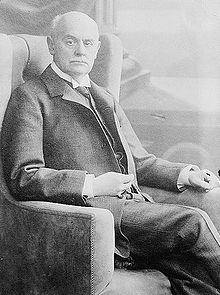Johann von Pallavicini
Marquess Johann von Pallavicini | |
|---|---|
 | |
| Austro-Hungarian Minister to Romania | |
| In office 26 January 1899 – 5 October 1906 | |
| Preceded by | Alois Freiherr Lexa von Aehrenthal |
| Succeeded by | Johann Prinz von Schönburg-Hartenstein |
| Austro-Hungarian Ambassador to Turkey | |
| In office 5 October 1906 – 11 November 1918 | |
| Preceded by | Heinrich Freiherr von Calice |
| Succeeded by | None |
| Personal details | |
| Born | 18 March 1848 Padua, Austrian Empire (from 1866, Italy) |
| Died | 4 May 1941 (aged 93) Pusztaradvány, Hungary |
| Spouse(s) | Georgina, née Reade Crowe (1862–1936) |
Marquess Johann von Pallavicini (German: Johann Markgraf von Pallavicini; Hungarian: Pallavicini János őrgróf; 18 March 1848 – 4 May 1941) was an Austro-Hungarian nobleman and diplomat, notably serving as ambassador at the Sublime Porte during World War I.
Life
[edit]He was born in Padua on 18 March 1848 into the ancient noble Pallavicini family. He entered the Austro-Hungarian foreign service after studies in Ödenburg (now Sopron) and Vienna. In 1871, he was dispatched as attaché to Berlin, in 1878 to Paris and in 1880 to London. In 1887, he was an embassy secretary in Belgrade and in 1894 a counselor in Munich before being sent to St. Petersburg the same year. He was appointed minister at Bucharest in January 1899.[1]
On 5 October 1906, Marquis[2] von Pallavicini was appointed ambassador at Constantinople (now Istanbul) by Emperor Franz Joseph I. In 1911, he temporarily acted as Foreign Minister during the illness of Count Lexa von Aehrenthal.[3] Marquis von Pallavicini was widely regarded as one of the most respected diplomats of the Dual Monarchy and was in difference to Count Lexa von Aehrenthal and many of the younger diplomats in Ballhausplatz against the annexation of Bosnia in 1908.[4]
During World War I, he successfully worked for bringing the Ottoman Empire into the war on the side of the Central Powers. Due to his long tenure and being the dean of the diplomatic corps in Constantinople, he was considered to wield a large influence over events in the Ottoman Empire. However, his role with regard to the Armenian Question has been debated by historians over the years and criticism has been raised that he did not protest loudly enough.[5] The reports that he sent to Vienna clearly show that he was aware of the nature of the Ottoman initiative and that it involved a "centrally planned and organised extermination".[6] Already in June 1915, he wrote to Vienna that "the Armenian population ... is not only being subjected to the greatest misery but also to a total extermination (einer gänzlichen Ausrottung)".[7] To his defence, however, records also show that he did protest but to no avail.[8]
In April 1917, Markgraf von Pallavicini politely declined Emperor Karl I's offer of becoming Foreign Minister.[9]
He was bestowed with the Grand Cross of the Order of Saint Stephen in 1917[10] and appointed a member of the Upper House in 1927.[11]
Marquis von Pallavicini died in Pusztaradvány on 4 May 1941.
Notes
[edit]Regarding personal names: Markgraf is a title, translated as Marquess, not a first or middle name. The female form is Markgräfin.
See also
[edit]References
[edit]- ^ 'Pallavicini János Markgraf von', Österreichisches Biographisches Lexikon 1815-1950, vol. 7, Vienna, Verlag der Österreichischen Akademie der Wissenschaften, 1957, p. 303.
- ^ Markgraf is sometimes translated as 'Margrave' in English. However, contemporary documents show that Markgraf von Pallavicini rather was referred to as a 'Marquis'
- ^ 'Inside Story of a Big Upset at the Austrian Court', New York Times, 19 March 1911
- ^ William D. Godsey, Aristocratic Redoubt: The Austro-Hungarian Foreign Office on the Eve of the First World War, West Lafayette, Purdue University Press, 1999, p. 202.
- ^ Donald Bloxham writes for example: "While Wangenheim issued notes of diplomatic protest, and his successor Paul Wolff-Metternich, backed by the Foreign Office, made enough noise about the killings on Germany's behalf for the CUP to demand his removal from office, Pallavicini remained in situ throughout the war, preferring instead to have periodic 'friendly words' with the CUP leaders." (Donald Bloxham, The Great Game of Genocide: Imperialism, Nationalism, and the Destruction of the Ottoman Armenians, Oxford, Oxford University Press, 2005, p. 125)
- ^ Vahakn N. Dadrian, The History of the Armenian Genocide: Ethnic Conflict from the Balkans to Anatolia to the Caucasus, Oxford, Berghahn Books, 1995, p. 424. For excerpts of Marquis von Pallavicini's reports, see Israel W. Charny (ed.), The Widening Circle of Genocide, New Brunswick, Rutgers State University, 1994, p. 102f.
- ^ Israel W. Charny (ed.), op. cit., p. 102.
- ^ Christopher J. Walker notes that, "By the end of June Wangenheim and his Austro-Hungarian colleague, Count Johann Pallavicini, decided to act together. On 1 July Pallavicini told Talaat that the mass deportations 'seemed hardly justified'. [...] The Porte, however, typically for a government in the grip of a racial frenzy, did nothing to either Austrian or German requests. Pallavicini noted, 'Evidently there is a determination to render the Armenian element, which has become so suspect here, harmless once and for all'." (Christopher J. Walker, Armenia: The Survival of a Nation, London, Routledge, 2nd edn., 1990, p. 232f.)
- ^ 'Pallavicini János Markgraf von', op. cit..
- ^ Magyar Királyi Szent István Rend Archived 2010-12-22 at the Wayback Machine
- ^ 'Pallavicini János, őrgróf', Magyar Életrajzi Lexikon
